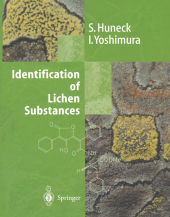 Neuerscheinungen 2012Stand: 2020-01-07 |
Schnellsuche
ISBN/Stichwort/Autor
|
Herderstra▀e 10
10625 Berlin
Tel.: 030 315 714 16
Fax 030 315 714 14
info@buchspektrum.de |

Siegfried Huneck, Isao Yoshimura
(Beteiligte)
Identification of Lichen Substances
Softcover reprint of the original 1st ed. 1996. 2012. xii, 493 S. XII, 493 pp. 67 figs. 242 mm
Verlag/Jahr: SPRINGER, BERLIN 2012
ISBN: 3-642-85245-9 (3642852459)
Neue ISBN: 978-3-642-85245-9 (9783642852459)
Preis und Lieferzeit: Bitte klicken
Saxony, Germany, died 1917 at Feuerbach near 1. 1 Stuttgart), who published 18 papers on lichen Short History of the Study substances in the period between 1861 and 1905 of Lichen Substances and wrote an article on Flechtenstoffe in the Lichens - symbiotic organisms of fungi and 1912 edition of Abderhalden┤s Biochemisches Handlexikon. algae - contain a great number of organic compounds, the so-called lichen substances The lichen substances first known in their structure were vulpinic acid (Spiegel 1883) and which are more or less typical of this group of cryptogames. The lichen substances com prise quite different classes of compounds like amino acid derivatives, sugar alcohols, aliphatic acids, ┤Y-, 0- and macrocyclic lactones, mono cyclic aromatic compounds, quinones, chromones, xanthones, dibenzofuranes, de psides, depsidones, depsones, terpenoids, ste roids and carotenoids. This multitude of compounds made the study of their chemistry attractive from the early times of organic chem istry. Bebert (1831) isolated vulpinic acid in 1831, Alms (1832) picrolichenic acid in 1832, and Knop (1844) usnic acid in 1844. Gmelin (1858) published a review on lichen substances already in 1858. The classical period of lichen chemistry is connected with two names: W. Zopf and O. Hesse. W. Zopf (Fig. 1) was a botanist (born 1846 at Ro:Bleben, Thuringia, Germany, died 1909 at Miinster/Westfalen) and published a series of papers on lichen substances which he summarized in the well-known book Die Flechtenstoffe in chemischer, botanischer, pharmakologischer und technischer Beziehung, published in 1907.
1 Introduction.- 1.1 Short History of the Study of Lichen Substances.- 1.2 General Meaning of Lichen Substances and Their Use in Past and Present Time.- 1.2.1 Biological Activities of Lichen Substances.- 1.2.2 Use of Lichens in Folk Medicine.- 1.2.3 Lichens as Raw Material for Dyes.- 1.2.4 Lichens as Basic Material for Perfume.- 1.2.5 The Biological Meaning of Lichen Substances.- 1.2.6 Lichens as Biomonitors.- 1.2.7 Lichens as Biodeterioration.- 1.2.8 Chemotaxonomy of Lichens.- 1.3 Culture of Lichens and Their Symbionts.- 2 Identification of Lichen Substances.- 2.1 Extraction and Purification of Lichen Substances.- 2.2 Melting Point.- 2.3 Colour Reactions and Other Reactions for the Identification of Lichen Substances.- 2.4 UV Spectroscopy.- 2.4.1 Depsides.- 2.4.2 Depsidones.- 2.4.3 ?-Lactones.- 2.4.4 Chromones and Xanthones.- 2.4.5 Dibenzofuranes.- 2.4.6 Pulvinic Acid Derivatives.- 2.4.7 Quinones.- 2.5 IR Spectroscopy.- 2.6 NMR Spectroscopy.- 2.6.1 1H-NMR Spectroscopy.- 2.6.2 13C-NMR Spectroscopy.- 2.7 Mass Spectrometry.- 2.8 Optical Rotation.- 2.9 Optical Rotatory Dispersion (ORD) and Circular Dichroism (CD).- 2.10 Microcrystallization.- 2.11 Thin Layer Chromatography.- 2.12 High Performance Liquid Chromatography (HPLC).- 2.13 Gas Liquid Chromatography (GLC).- 2.14 X-Ray Analysis.- 2.15 Laser Microprobe Mass Spectrometry (LAMMA).- 2.16 Derivatization.- 2.17 Cleavage of Depsides.- 3 Data of Lichen Substances.- 3.1 General Remarks and Abbreviations of the Data.- 3.2 N-Containing Compounds.- 3.3 P-Containing Compounds.- 3.4 S-Containing Compounds.- 3.5 Polyols, Monosaccharides, Carbohydrates.- 3.6 Aliphatic and Cycloaliphatic Compounds.- 3.6.1 Neutral Compounds.- 3.6.2 Acids.- 3.7 Aromatic Compounds.- 3.7.1 Monocyclic Aromatic Compounds.- 3.8 Quinones.- 3.8.1 Benzoquinones.- 3.8.2 Naphthaquinones and bis-Naphthaquinones.- 3.8.3 Anthraquinones, Anthrones, bis-Anthraquinones and bis-Anthrones.- 3.8.4 Biphenylquinones.- 3.8.5 Terphenylquinones.- 3.8.6 Phenanthrenequinones.- 3.8.7 Perylenequinones.- 3.9 Chromanes and Chromones.- 3.10 Xanthones and bis-Xanthones.- 3.11 Dibenzofuranes.- 3.12 Diphenylether.- 3.13 Biphenyls.- 3.14 Diphenylmethanes.- 3.15 Nostoclides.- 3.16 Depsides.- 3.16.1 Didepsides.- 3.16.2 Tri- and Tetra-Depsides.- 3.16.3 Benzyldepsides.- 3.17 Depsidones.- 3.18 Depsones.- 3.19 Naphthopyranes.- 3.20 Terpenoids.- 3.20.1 Monoterpenoids.- 3.20.2 Sesquiterpenoids.- 3.20.3 Diterpenoids.- 3.20.4 Sesterterpenoids.- 3.20.5 Triterpenoids.- 3.20.6 Steroids.- 3.20.7 Carotenoids.- 3.21 Pulvinic Acid Derivatives.- 3.22 Cleavage Products of Depsides and Depsidones.- Literature.- Addenda.


